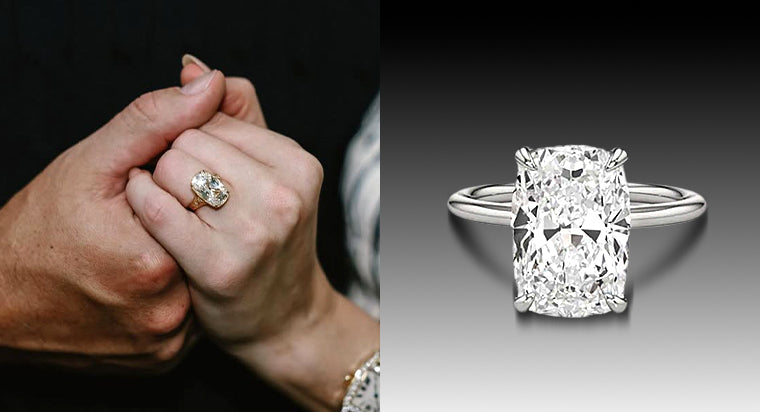Are Lab Grown Diamond Engagement Rings as Durable as Natural Diamonds?

Lab diamonds and natural diamonds are often discussed, but you might not be familiar with how they compare. Buying an engagement ring is a significant deal, and this understanding can help you make an informed decision.
TABLE OF CONTENTS
Composition and Structure
Lab grown diamonds are chemically equivalent to natural diamonds because both are made entirely of carbon atoms arranged in a crystal lattice structure. This means that whether they form deep within the Earth's mantle or in a high-tech lab, the carbon atoms bond in the same way, creating the stunning clarity and sparkling brilliance that diamonds are known for. Essentially, a lab grown diamond has the exact optical, chemical and physical characteristics as that of a natural diamond. So, when you look at a lab grown diamond, you see the same sparkling beauty that nature creates–it simply crafted in a more controlled and eco-friendly environment.
Hardness and Scratch Resistance
Gemstone hardness is measured using the Mohs hardness scale, where 1 is the softest and 10 is the hardest. Both mined and lab diamonds are a 10 out of 10 on the Mohs scale, indicating they're scratch-resistant and durable. The stones are strong and suitable for everyday wear.
Impact Resistance
Both natural and lab grown diamonds are incredibly hard, so they're highly resistant to scratches and everyday wear. However, despite their hardness, diamonds can still chip or break if exposed to extreme force or sharp impacts. This is because diamonds have a crystal structure, and although that makes them tough, it also makes them brittle in certain directions. If the stone gets hit hard or in just the spot, it can chip or break.
Longevity and Wear
Diamond durability and their beauty make them ideal for engagement rings. They can be heirloom rings and be passed down from generation to generation with proper care. Regular maintenance and care can ensure dirt and grime aren't dulling your stones or your setting. Regular cleaning and inspections can help you be proactive about loose stones, damaged prongs, or any other necessary repairs. Taking your engagement ring to a professional jeweler can get a fresh set of expert eyes on your ring to make sure your diamonds are safe and secure.
Certification and Standards
Both natural and lab diamonds have certified options–GIA for natural diamonds and IGI for lab diamonds. Certified diamonds come with a detailed report about your diamond. It will include the grades for cut, color, clarity, and carat weight and prove your diamond's authenticity. This option reassures consumers about the stone's quality and provides peace of mind.
Market Acceptance and Warranty
Lab grown diamonds continue to gain more widespread acceptance in the jewelry industry as consumers become more familiar with their benefits and quality. In the past, there were more myths than facts about diamonds, meaning there were plenty of educational opportunities. Many jewelers offer mined and lab grown diamonds both to ensure men and women can get the type of diamond they prefer, and it aligns with their personal values. Jewelers offer similar warranties for diamonds. These warranties typically cover aspects like chipping, cracking, and any potential issues with the settings, giving buyers peace of mind that their engagement ring is protected.
Environmental Considerations
While natural and mined diamonds look identical, their origin makes each one unique. Lab diamonds are created in a controlled environment rather than mined from the Earth, so they have minimal environmental impact. Some couples have their heart set on a sustainable and ethical diamond, so if that's the case, a lab diamond engagement ring is the way to go.
Consumer Insights and Trends
Consumer preferences regarding the durability of both natural and lab diamonds for engagement rings continue to evolve with time with several trends and shifts emerging. While a natural diamond is a traditional choice, more couples are putting their own preferences and values first. Couples are opting for lab grown diamonds due to their affordability, ethical production, and identical physical properties. Modern consumers, particularly millennials and Gen Z, seem to prioritize sustainability and value for money, making lab grown diamonds an appealing choice.
In terms of durability, both lab and mined diamonds offer the same level of hardness and resilience, which helps make engagement rings suitable for everyday wear. The increasing acceptance of lab grown diamonds has boosted their popularity, assuring buyers of their lasting quality and durability. Many couples appreciate the opportunity to invest in a larger or higher-quality stone at a lower price point, without compromising on durability or beauty.
Expert Opinions and Studies
Several studies, expert opinions, and industry reports have compared the durability of natural and lab grown diamonds, generally finding that both types share comparable properties. The Gemological Institute of America (GIA) provides education and research on all gemstones, including diamonds. Their research concluded that lab grown diamonds are optically physically and chemically identical to natural diamonds, which translates to similar durability and performance in everyday use. Both types rate a 10 on the Mohs scale, indicating exceptional hardness.
Experts like Dr. James Shigley, a distinguished research fellow at GIA, have emphasized that lab diamonds exhibit the same wear and tear characteristics as natural diamonds due to their identical crystal structure. Industry reports support these findings. Their report noted that the production processes for lab diamonds, such as HPHT and CVD, create gems with the same hardness and resistance to scratching and chipping as mined diamonds.
Conclusion
Both mined and lab diamonds are highly durable, which makes them suitable for engagement rings. Diamonds are extremely hard and resistant to scratching. Regular care and maintenance can help your ring last for generations. Consumers can choose either mined or lab diamonds based on personal preferences, ethical considerations, and their budget.









